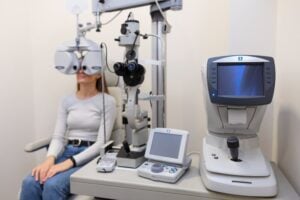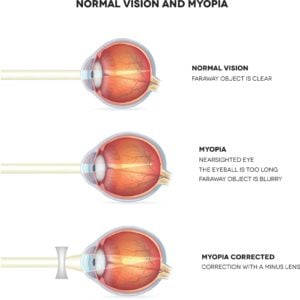Nearsightedness, or myopia, is a refractive error that makes distant objects appear blurry. Farsightedness, or hyperopia, is a refractive error that makes near objects appear blurry.
An eye exam is an accurate way to determine whether you’re nearsighted or farsighted.
Depending on the severity, your doctor may prescribe treatment options that range from corrective lenses to vision correction surgery.
Understanding the differences and causes of these conditions makes it easier to identify symptoms early.

Astigmatism vs. Nearsightedness
Astigmatism is a type of refractive error that causes blurry vision both near and far. It occurs when an irregular cornea or lens curvature leads to distorted images.
On the other hand, nearsightedness is a refractive error that causes blurry vision at a distance. With myopia, the eye is elongated (steep cornea), causing light to focus in front of the retina rather than on it.
What is Nearsightedness?
Nearsightedness (myopia) occurs when the eyeball is too long, or the cornea is too curved. This causes light rays that enter the eye to refract in front of the retina.
Myopia affects children and adults, although the numbers are higher among school-aged children. The American Optometric Association (AOA) estimates over 40% of Americans have this condition and projects a steady increase in the coming years.
How is Nearsightedness Diagnosed?
Here are some ways to diagnose nearsighted vision:
Eye Test
An eye doctor performs several tests to determine how your eyes focus light during the initial diagnosis. One of the tests involves identifying letters from a vision chart to measure the sharpness of your vision within a 20-foot distance.
The doctor records the test results in a fraction format where the numerator is the standard test distance (20 feet). The denominator is the distance from which someone with normal vision can see an object, but the patient can only see the same object from 20 feet.
Phoropter
The doctor may also use a phoropter to test your vision. This device uses several lenses to measure the refraction of light entering your eyes.
The results of this test determine the type of vision correction lenses you need.
What are the Symptoms of Nearsightedness?
The main symptom of nearsightedness is blurry vision when looking at faraway objects.
Other common symptoms of nearsightedness include:
- Squinting to see objects that are far away
- Difficulty watching TV or driving at night
- Headaches caused by eyestrain
- Eye tiredness when focusing on distant objects
- Trouble reading a whiteboard in school (children)
What Causes Nearsightedness?
Some environmental factors and health conditions can cause myopia. However, given the complexities of its diagnosis, additional studies are needed to confirm this.
Gene Mutations
Studies link myopia to gene mutations with at least seven variations in one type of gene. More than 200 genes are involved in the mutations that cause nearsightedness.
Environmental Factors
Other than gene mutation, these common factors can also contribute to nearsightedness:
- Intensive work focusing on near objects
- Reading, writing, or working on a computer for many hours in a day
- Low-light environments that make it difficult for the eyes to focus on objects
- Night myopia caused by increased pupil size
Health Conditions
Myopia can also result from health conditions like:
- Cataracts
- Diabetes (variations in blood sugar levels)
- Blunt eye trauma
- Eye inflammation
What is Farsightedness?
Farsightedness (hyperopia) occurs when light entering the eye refracts behind the retina instead of on the retina.
Farsightedness affects about 5 to 10 percent of Americans. However, most people never realize they have this condition because of its diverse symptoms, especially during childhood.
For example, many farsighted people have blurry vision when looking at close and distant objects.
How is Farsightedness Diagnosed?
Here are some ways to diagnose farsightedness:
Comprehensive Eye Exam
Farsightedness is diagnosed through a comprehensive eye exam to determine how your eye refracts light.
Vision screening tests that involve identifying letters on a chart usually don’t detect hyperopia effectively. A comprehensive eye exam includes several tests, such as visual acuity, topography, eye health tests, refraction tests, and more.
Retinoscopy
Retinoscopy can diagnose refractive errors, both nearsightedness and farsightedness. During the procedure, an eye doctor examines the retina to determine light refraction.
An optometrist usually performs a retinoscopy. They use a handheld tool called a retinoscope, which consists of a beam of light, a condensing lens, and a mirror.
Note: Most optometrists use autorefractors now instead of retinoscopes. They’re more accurate and much faster.
What are the Symptoms of Farsightedness?
Because farsighted people experience different vision problems, the symptoms can be confusing. Some farsighted people have blurry vision when looking at distant objects. However, this symptom is generally associated with nearsightedness.
Besides consulting a doctor for proper diagnosis, you may be farsighted if you have some of these symptoms:
- General eye strain and discomfort when accomplishing certain close-up tasks, like reading or working on a computer
- Eye strain when focusing on near objects
- Eye squinting
- Headaches caused by eyestrain
- Near objects appear blurry
- Burning sensation and ache around the eye
What Causes Farsightedness?
When light enters a normal eye, the cornea refracts it on the retina. The cornea is the eyeball’s clear outer part that focuses light, helping you see clearly. It is dome-shaped, enabling it to refract light onto the retina.
If the cornea is too flat, it refracts light behind the retina, causing near objects to appear blurry.
Farsightedness also occurs when the eyeball is short. This forces light to refract behind the retina. Other causes of farsightedness include:
- Other refractive errors, such as astigmatism
- Loss of flexibility of the eye lens (presbyopia)
- Flattened cornea
- Aging
Treatment Options for Refractive Errors
Depending on the severity of the refractive error, a doctor may recommend one of the following treatment options:
Glasses
The easiest and safest treatment option for myopia and hyperopia is to wear glasses. Depending on the results of your eye exam, your doctor will write an eyeglasses prescription to correct your vision.
Contacts
Contact lenses create the first surface that refracts light entering the eye. Wearing contact lenses is another way to correct distance vision. As a result, they correct how the eye refracts light onto the retina.
LASIK
Laser-assisted in situ keratomileusis (LASIK) is an eye surgery that corrects the shape of the corneal tissue. The surgery only takes about 10 minutes for each eye and effectively treats myopia, hyperopia, and astigmatism. This treatment provides a long-term solution for correcting many refractive errors.
Other Refractive Surgeries
Other refractive surgeries include PRK, SMILE, refractive lens exchange (RLE), and phakic intraocular lens, among others.
Summary
Nearsightedness and farsightedness are two of the most common refractive errors. It occurs when light is refracted in front of the retina, while farsightedness results from light being focused behind the retina.
Astigmatism is also a common refractive error, but it occurs when you have an irregular cornea or lens curvature. The most common treatment options for refractive errors include glasses, contacts, and surgery.
In this article







